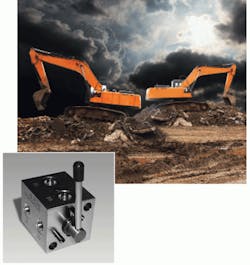When two of the largest manufacturers of hydraulic excavators each design a different operating pattern for the two joysticks that control the pilot circuits on their machines, it’s highly likely that both patterns will appear in the field. That’s exactly what has happened. Although SAE selected the Caterpillar pattern as its voluntary standard, John Deere and other equipment manufacturers produced many machines with the John Deere pattern. Both patterns also appear on other types of equipment. (Designs on new excavators, however, seem to be trending toward the SAE arrangement.)
For contractors that own only one excavator, the pattern is not critical. But for larger contractors or rental operations with a fleet of multiple-brand excavators, matching the joystick pattern to a particular operator’s skills can be a real headache.
A mechanic can disconnect and reconnect a couple of hoses at the main valve bank to reconfigure the system for either joystick pattern — but this takes time, probably spills some oil, and gives contamination an opportunity to enter the system. A simpler, cleaner approach is to install Holmbury’s joystick-pattern changer valve between the joysticks and the valve bank. This two-position/eight-way, lever-actuated valve incorporates four inlet and four outlet ports to accommodate both flow patterns within its 2 × 2 × 2.34-in. steel body. It changes from one to the other and back again with an easy 90° flip of a lever. Rated at 3,000 psi, the valve is rated for pilot flows and its strictly manual design has no electrical parts to fail. (A tamper-proof version with no handle also is available.)
Holmbury products are available in North America from Holmbury Inc., Eastlake, Ohio, (800) 860-5597.


